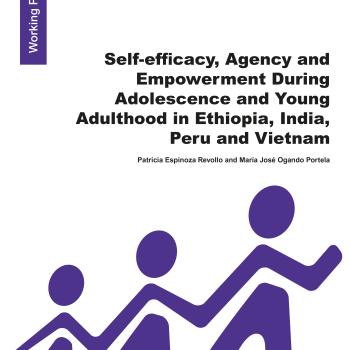
This working paper examines gender gaps in empowerment and the timing of their emergence through adolescence and young adulthood for two cohorts of children living in Ethiopia, India, Peru and Vietnam. It uses longitudinal data from Young Lives on two psychosocial competencies – self-efficacy and agency – associated with the notion of empowerment. In all four countries, gaps in self-efficacy emerge in late adolescence, widening particularly between the ages of 15 and 19 and favouring boys. The results are more heterogeneous for agency; gaps widen between the ages of 12 and 15 and favour boys in Ethiopia and India, and girls in Peru and Vietnam. However, for the latter, the gaps close or even reverse in favour of boys by age 22. Our analysis pays special attention to the sub-national context: whether young people grow up in urban or rural areas. We find important gaps for rural girls, who show the lowest levels of agency and self-efficacy across the four countries. Finally, we explore the relationship between background characteristics and these two measures in mid-adolescence and young adulthood (ages 15 and 22). We find that these outcome measures correlate positively with the socio-economic level of the household in which they were born and grew up.

This working paper examines gender gaps in empowerment and the timing of their emergence through adolescence and young adulthood for two cohorts of children living in Ethiopia, India, Peru and Vietnam. It uses longitudinal data from Young Lives on two psychosocial competencies – self-efficacy and agency – associated with the notion of empowerment. In all four countries, gaps in self-efficacy emerge in late adolescence, widening particularly between the ages of 15 and 19 and favouring boys. The results are more heterogeneous for agency; gaps widen between the ages of 12 and 15 and favour boys in Ethiopia and India, and girls in Peru and Vietnam. However, for the latter, the gaps close or even reverse in favour of boys by age 22. Our analysis pays special attention to the sub-national context: whether young people grow up in urban or rural areas. We find important gaps for rural girls, who show the lowest levels of agency and self-efficacy across the four countries. Finally, we explore the relationship between background characteristics and these two measures in mid-adolescence and young adulthood (ages 15 and 22). We find that these outcome measures correlate positively with the socio-economic level of the household in which they were born and grew up.

